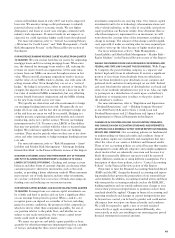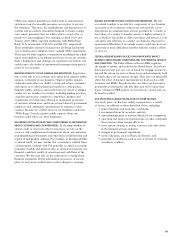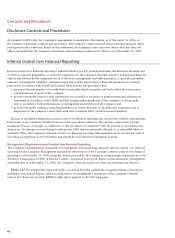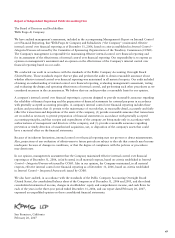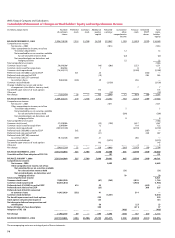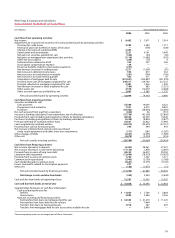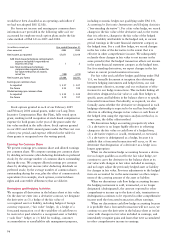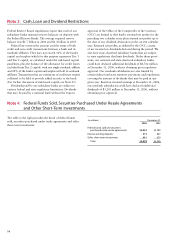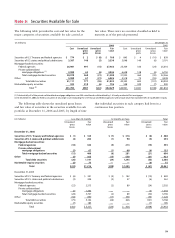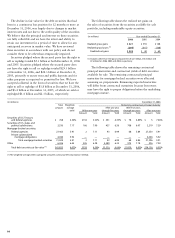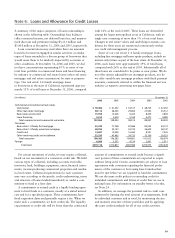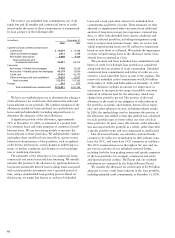Wells Fargo 2006 Annual Report Download - page 74
Download and view the complete annual report
Please find page 74 of the 2006 Wells Fargo annual report below. You can navigate through the pages in the report by either clicking on the pages listed below, or by using the keyword search tool below to find specific information within the annual report.
72
Notes to Financial Statements
Wells Fargo & Company is a diversified financial services
company. We provide banking, insurance, investments, mort-
gage banking and consumer finance through banking stores,
the internet and other distribution channels to consumers,
businesses and institutions in all 50 states of the U.S. and in
other countries. In this Annual Report, when we refer to
“the Company,” “we,” “our” or “us” we mean Wells Fargo
& Company and Subsidiaries (consolidated). Wells Fargo &
Company (the Parent) is a financial holding company and a
bank holding company.
Our accounting and reporting policies conform with
U.S. generally accepted accounting principles (GAAP) and
practices in the financial services industry. To prepare the
financial statements in conformity with GAAP, management
must make estimates and assumptions that affect the reported
amounts of assets and liabilities at the date of the financial
statements and income and expenses during the reporting
period. Management has made significant estimates in several
areas, including the allowance for credit losses (Note 6),
valuing residential mortgage servicing rights (Notes 20 and
21) and pension accounting (Note 15). Actual results could
differ from those estimates.
In the Financial Statements and related Notes, all common
share and per share disclosures reflect the two-for-one stock
split in the form of a 100% stock dividend distributed
August 11, 2006.
The following is a description of our significant
accounting policies.
Consolidation
Our consolidated financial statements include the accounts
of the Parent and our majority-owned subsidiaries and vari-
able interest entities (VIEs) (defined below) in which we are
the primary beneficiary. Significant intercompany accounts
and transactions are eliminated in consolidation. If we own
at least 20% of an entity, we generally account for the
investment using the equity method. If we own less than
20% of an entity, we generally carry the investment at cost,
except marketable equity securities, which we carry at fair
value with changes in fair value included in other compre-
hensive income. Assets accounted for under the equity or
cost method are included in other assets.
We are a variable interest holder in certain special-
purpose entities in which we do not have a controlling
financial interest or do not have enough equity at risk for the
entity to finance its activities without additional subordinated
financial support from other parties. Our variable interest
arises from contractual, ownership or other monetary interests
in the entity, which change with fluctuations in the entity’s
net asset value. We consolidate a VIE if we are the primary
beneficiary because we will absorb a majority of the entity’s
expected losses, receive a majority of the entity’s expected
residual returns, or both.
Trading Assets
Trading assets are primarily securities, including corporate
debt, U.S. government agency obligations and other securities
that we acquire for short-term appreciation or other trading
purposes, and the fair value of derivatives held for customer
accommodation purposes or proprietary trading. Trading
assets are carried at fair value, with realized and unrealized
gains and losses recorded in noninterest income. Noninterest
income from trading assets was $544 million, $571 million
and $523 million in 2006, 2005 and 2004, respectively.
Securities
SECURITIES AVAILABLE FOR SALE Debt securities that we might
not hold until maturity and marketable equity securities are
classified as securities available for sale and reported at esti-
mated fair value. Unrealized gains and losses, after applicable
taxes, are reported in cumulative other comprehensive income.
We use current quotations, where available, to estimate the
fair value of these securities. Where current quotations are
not available, we estimate fair value based on the present
value of future cash flows, adjusted for the credit rating of
the securities, prepayment assumptions and other factors.
We reduce the asset value when we consider the declines
in the value of debt securities and marketable equity securities
to be other than temporary and record the estimated loss
in noninterest income. We conduct other-than-temporary
impairment analysis on a quarterly basis. The initial indica-
tor of other-than-temporary impairment for both debt and
equity securities is a decline in market value below the
amount recorded for an investment, and the severity and
duration of the decline. In determining whether an impair-
ment is other than temporary, we consider the length of time
and the extent to which market value has been less than
cost, any recent events specific to the issuer and economic
conditions of its industry, and our ability and intent to hold
the investment for a period of time sufficient to allow for
any anticipated recovery.
For marketable equity securities, we also consider the
issuer’s financial condition, capital strength, and near-term
prospects.
For debt securities we also consider:
• the cause of the price decline— general level of interest
rates and industry and issuer-specific factors;
• the issuer’s financial condition, near term prospects
and current ability to make future payments in a
timely manner;
• the issuer’s ability to service debt; and
• any change in agencies’ ratings at evaluation date from
acquisition date and any likely imminent action.
The securities portfolio is an integral part of our asset/
liability management process. We manage these investments
to provide liquidity, manage interest rate risk and maximize
Note 1: Summary of Significant Accounting Policies



